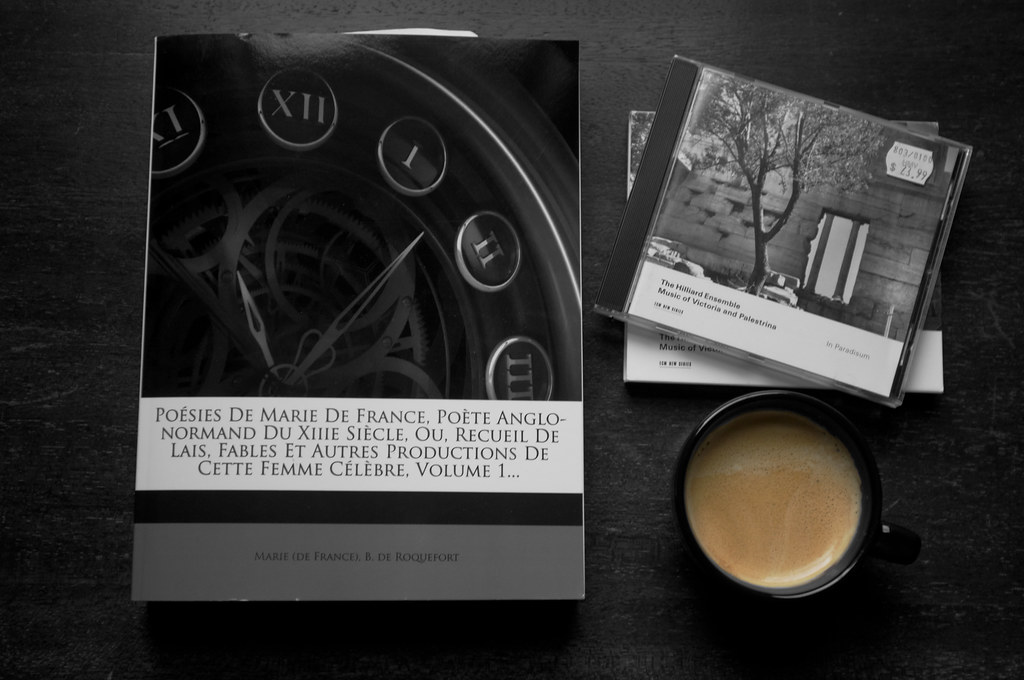Women in Rhetoric
Whitney Authement

“Dimanche matin Monochrome – Monochrome Sunday Morning” by bob august is licensed under CC BY-NC-SA 2.0
Marie de France is most prominently known for her contributions to medieval poetry as France’s first female poet. Her notable works include the Lais, the Fables, and St. Patrick’s Purgatory. Her writing was wildly popular in her time and translated into multiple languages. She explored themes such as gender, chivalry, sexuality, and nobility. She influenced many poets who came after her; some even speculate that some of the stories in Geoffrey Chaucer’s The Canterbury Tales were inspired by Marie and her work in the fabliaux genre.
Though Marie de France is widely accepted as France’s first woman poet, her true identity has eluded researchers for centuries. Very few details of Marie’s life are known for certain, and her only comment on her identity comes from the original epilogue of Fables. She wrote, “Marie ai nun, si sui de France,” which in English means “Marie is my name, and I am from France.” Despite the lack of autobiographical information in her writing, researchers believe that she was likely the illegitimate child of Geoffrey IV of Anjou and the half sister to King Henry II of England. These details place her in the English royal court during the 12th century. Her being of illegitimate birth also explains why her writing displays the education of nobility, but records of her existence have yet to be discovered. Still, there is no concrete evidence to support this theory. The true identity of Marie de France may never be known for certain.
Her influences on rhetoric lie in her inversion of themes traditionally represented in Briton lais. Traditionally lais were a poetic representation of romantic stories and were meant to be performed as songs. They often depicted chivalrous love stories, where the damsel in distress archetype is prominent. Marie de France, who wrote that she was unable to find a job translating, took it upon herself to write them down. However, in opposition to traditional lais, Marie De France’s versions centered around women who play a major role in the plot. The women depicted in her work often made speeches at the beginning of the stories that influenced the actions of the male characters. These works showed woman as powerful beings, for better and for worse. The lais also acted as cautionary tales in which either the man or woman would suffer as a result of their love. Marie is credited with connecting the eloquence of speech with poetry and asserted that it was a gift that should be shared. A translation of the Prologue to the Lais is cited as saying “He to whom God has given knowledge/And the gift of speaking eloquently/Must not keep silent or conceal the gift/But he must willingly display it.” This challenged the popular opinion of the time that poetry was simply a matter of arranging words in a pleasing way.
Though we may never learn the identity of Marie de France, it is certain that her poetry is an inspiring display of one woman’s ability in rhetoric. Original manuscripts of her lais can still be seen at the British Library.
Sources
- Koster, J. “Marie De France.” Marie De France, Winthrop University, faculty.winthrop.edu/kosterj/engl310h/marie.htm.
- “The Lays and Fables of Marie de France.” The British Library, The British Library, 22 Sept. 2017, www.bl.uk/collection-items/the-lays-and-fables-of-marie-de-france.
